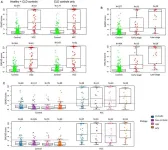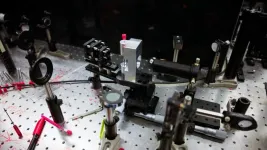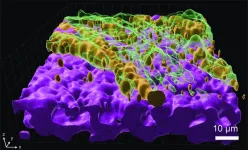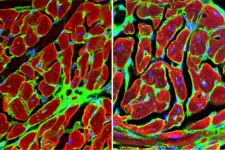New machine learning model quickly and accurately predicts dielectric function
The model speeds up dielectric materials development as a step toward 6G networks
2024-10-25
(Press-News.org)
Researchers Tomohito Amano and Shinji Tsuneyuki of the University of Tokyo with Tamio Yamazaki of CURIE (JSR-UTokyo Collaboration Hub) have developed a new machine learning model to predict the dielectric function of materials, rather than calculating from first-principles. The dielectric function measures the polarization of negative and positive charges within materials, the phenomenon underlying dielectric materials. Thus, the fast and accurate prediction of dielectric function facilitates the development of novel dielectric materials, an ingredient of many cutting-edge technologies such as 6G networks. The findings were published in the journal Physical Review B.
Although they might not be as widely known as semiconductors, dielectric materials have great potential to improve modern electronic systems. Dielectric materials do not conduct electricity well, but they are not insulators either. Instead, when placed in an electric field, positive charges within the material shift toward the field and negative charges away from it, resulting in dielectric polarization. The dielectric function is the measure of the strength of polarization. However, calculating the dielectric function meant calculating it from first- principles using quantum mechanics, a computationally slow and heavy process.
“The study of dielectrics is important both for fundamental and applied science,” says Amano, the first author. “On the fundamental side, dielectrics can help elucidate the microscopic origin of how materials respond to electric fields. On the applied side, low-dielectric polymer materials for high-speed communication have garnered attention recently.”
So, the researchers set out to develop a machine learning model that could help address these challenges. They generated training data for the algorithm by doing first-principle calculations of the electronic state of various materials. Moreover, instead of the conventional calculations based on individual molecules, they based their model on the chemical bonds between atoms. The researchers then checked the accuracy of the model by comparing its results to empirical data of simple molecules such as methanol and ethanol.
The model was a success. It not only described the electronic state of various materials close to the accuracy of first-principle calculations, it did so with a fraction of the computational burden. The model also proved to be useful for large-scale and long-time simulations. As computational costs have been the limiting factor, this model makes it possible for the first time to address the macroscopic origin of the dielectric properties of many-molecule systems.
Despite these achievements, Amano is already looking ahead.
“In this work, we investigated the dielectric properties of simple molecules, but application to more complex molecules, including polymers, is yet to be done. So, we are also planning to construct a universal neural network that can be used in industry.”
END
[Attachments] See images for this press release:
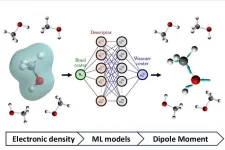
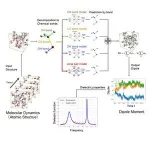
ELSE PRESS RELEASES FROM THIS DATE:
2024-10-25
The information environment in Finland during the coronavirus pandemic was exceptional and intense in many ways. The spread of disinformation and the number of actors involved reached unprecedented levels. The demand for accurate information was enormous, and the situation was constantly evolving. Information was disseminated through various channels. Official information played a crucial role, but at the same time, social media posed challenges in the fight against false and misleading information.
Malicious bots increased significantly during the pandemic. The operation of bots – i.e. ...
2024-10-25
Background and objectives
Depression can lead to poor outcomes during antiretroviral therapy, and current evidence suggests high rates of depression among people living with human immunodeficiency virus (PLHIV), especially in low-and middle-income countries. This study was designed to investigate the sociodemographic factors associated with depression among PLHIV on antiretroviral therapy in a Nigerian cosmopolitan city.
Methods
A hospital-based, cross-sectional study was conducted among 592 consenting, ...
2024-10-25
Background and Aims
Early detection of hepatocellular carcinoma (HCC) is crucial for improving survival in patients with chronic hepatitis. The GALAD algorithm combines gender (biological sex), age, α-fetoprotein (AFP), Lens culinaris agglutinin-reactive fraction of AFP (AFP-L3), and protein induced by vitamin K absence or antagonist-II (PIVKA-II) for HCC detection. Similarly, the GAAD algorithm incorporates gender (biological sex), age, AFP, and PIVKA-II. This study aimed to assess the clinical utility of AFP-L3 in the GALAD algorithm and its potential synergies with ultrasound. We compared the clinical performance of GALAD with GAAD; AFP; AFP-L3; and PIVKA-II, with ...
2024-10-25
Background and Aims
Data regarding risk factors and long-term outcomes of U.S. patients with biopsy-proven metabolic dysfunction-associated steatotic liver disease (MASLD) are limited. This study aimed to investigate the role of clinical and histologic risk factors on long-term outcomes in patients with MASLD.
Methods
A retrospective cohort study of 451 adults with biopsy-proven MASLD was conducted at a U.S. academic hospital from 2012 to 2020. An experienced pathologist evaluated the index liver biopsy. Patients with a prior liver transplant or alternative etiologies of chronic liver disease were excluded. The duration ...
2024-10-25
Water is synonymous with life, but the dynamic, multifaceted interaction that brings H2O molecules together – the hydrogen bond – remains mysterious. Hydrogen bonds result when hydrogen and oxygen atoms between water molecules interact, sharing electronic charge in the process. This charge-sharing is a key feature of the three-dimensional ‘H-bond’ network that gives liquid water its unique properties, but quantum phenomena at the heart of such networks have thus far been understood only through theoretical simulations.
Now, researchers led by Sylvie Roke, head of the Laboratory for Fundamental BioPhotonics in EPFL’s School of Engineering, ...
2024-10-25
Subtle temperature differences at the ocean surface allow more carbon dioxide (CO₂) to be absorbed, new research shows.
Scientists studied the “ocean skin” – a sliver less than 2 mm deep at the ocean surface that is fractionally cooler than the rest.
Theoretical and lab work have suggested this temperature difference should increase the amount of CO₂ absorbed by the ocean – but this had never been successfully observed at sea before.
The new study – led by researchers from the University of Exeter’s Penryn Campus in Cornwall – used precision measurements to confirm that the ...
2024-10-25
URBANA, Ill. — Invasive silver carp have been spreading throughout the Mississippi River Basin since their introduction a half-century ago. Yet, try as they might, the fish have not advanced beyond a particular stretch of the Illinois River north of Kankakee. Research from the University of Illinois Urbana-Champaign shows the fish are likely avoiding contaminants from the Chicago Area Waterway, which flows south before petering out around Kankakee.
A new study, published today in Scientific Reports, shows silver carp change their behavior and metabolism when introduced to water from the Illinois River north of Kankakee, representing Chicago-area water.
“When animals ...
2024-10-25
Imagine trying to settle into a new home while constantly being attacked. That’s what the bacterium Pseudomonas aeruginosa faces when it infects the lungs, and it can’t both spread and protect itself from antibiotics at the same time. Nonetheless, it’s one of the top culprits in hospital-acquired infections and it’s notorious for causing long-lasting, antibiotic-resistant infections, causing damage especially in people with lung diseases like cystic fibrosis, COPD, or bronchiectasis.
To survive tough conditions, P. aeruginosa forms colonies ...
2024-10-25
University of Oxford researchers have made a significant step towards realising miniature, soft batteries for use in a variety of biomedical applications, including the defibrillation and pacing of heart tissues. The work has been published today in the journal Nature Chemical Engineering.
The development of tiny smart devices, smaller than a few cubic millimeters, demands equally small power sources. For minimally invasive biomedical devices that interact with biological tissues, these power sources must be fabricated from soft materials. Ideally, these should ...
2024-10-25
FINDINGS
UCLA scientists have identified the protein GPNMB as a critical regulator in the heart’s healing process after a heart attack.
Using animal models, they demonstrate that bone marrow-derived immune cells called macrophages secrete GPNMB, which binds to the receptor GPR39, promoting heart repair. These findings offer a new understanding of how the heart heals itself and could lead to new treatments aimed at improving heart function and preventing the progression to heart failure.
BACKGROUND
Every 40 seconds, ...
LAST 30 PRESS RELEASES:
[Press-News.org] New machine learning model quickly and accurately predicts dielectric function
The model speeds up dielectric materials development as a step toward 6G networks


